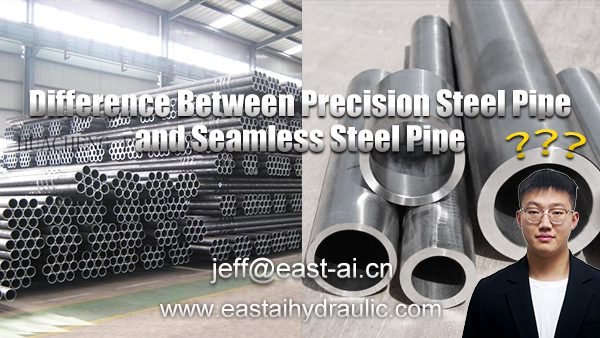When comparing precision steel pipes and seamless steel pipes, it’s essential to understand their unique features, manufacturing processes, and applications. The table below highlights the key differences between the two:
| Feature | Precision Steel Pipe | Seamless Steel Pipe |
| Definition | High-precision steel tube processed by cold drawing (or sometimes hot rolling) | Steel pipe with no welded seams, produced by hot rolling or cold drawing |
| Surface Quality | Smooth inner and outer walls, no oxide layer | May have some surface roughness depending on the manufacturing process |
| Tolerance and Dimensions | Strict tolerance levels for inner and outer dimensions, high precision | Less strict tolerances, suitable for general use |
| Manufacturing Process | Typically cold drawn, sometimes hot rolled | Made by hot rolling or cold drawing, starting from steel ingots or billets |
| Pressure Resistance | High-pressure resistance, can withstand cold bending without deformation | Can withstand high pressure, suitable for fluid transport |
| Applications | Hydraulic and pneumatic systems, such as cylinders | Pipelines for transporting fluids, structural and mechanical parts (e.g., oil drill pipes, bicycle frames) |
| Chemical Composition | Controlled for precision applications, typically includes C, Si, Mn, S, P, Cr | Varies by application, designed to withstand high pressure or mechanical stress |
| Key Advantage | High precision and smooth surface for specialized applications | High strength and no seams, making them ideal for high-pressure applications |

Key Characteristics of Each Pipe
Precision Steel Pipe
Precision steel pipes are known for their high precision and smooth surfaces, achieved primarily through cold drawing and sometimes hot rolling. They feature strict tolerances for both inner and outer dimensions, ensuring exceptional accuracy. These pipes have a smooth inner and outer wall, no oxide layers, and can withstand high pressure without leaking. They also retain their shape when cold bent and can handle flaring and flattening without cracking. Due to these characteristics, precision steel pipes are primarily used in applications requiring high precision and quality surfaces, such as hydraulic and pneumatic systems, including cylinders.
The chemical composition of precision steel pipes is carefully controlled to ensure their high strength and precision. Common elements include carbon (C), silicon (Si), manganese (Mn), sulfur (S), phosphorus (P), and chromium (Cr), which contribute to their durability and high performance.
Seamless Steel Pipe
Seamless steel pipes are characterized by the absence of welded seams, making them capable of withstanding high pressures. They are manufactured by hot rolling or cold drawing, starting with steel ingots or solid tube billets that are perforated to create a hollow section. These pipes are highly versatile, used extensively in pipelines for transporting fluids (such as oil, gas, and water) and in the construction of various structural and mechanical parts, such as oil drill pipes, automotive transmission shafts, and bicycle frames.
The primary advantage of seamless steel pipes lies in their ability to handle high pressures and provide significant strength without the risk of weld seam failures. They are considered economical due to their lightweight compared to solid steel alternatives like round bars, while still offering comparable torsional and bending strength.
EN 10305-1 E215 Seamless Precision Steel Tube
A specific example of a precision steel pipe is the EN 10305-1 E215 Seamless Precision Steel Tube.
These tubes are manufactured to meet the EN 10305-1 standard and are made from E215 material. The production technique used is cold-drawn seamless processing, which ensures a high level of precision and quality.
- Outer Diameter (OD): 4-260 mm
- Wall Thickness (WT): 0.5-25 mm
- Length: 3-8 meters
These tubes are widely used in industries such as automotive and machining, where high precision and smooth surface quality are crucial. The cold-drawn seamless process makes them particularly suitable for applications that require tight tolerances and excellent mechanical properties.
Summary of Differences
- Precision Steel Pipe: Developed for applications requiring high precision, such as hydraulic and pneumatic systems, these pipes offer strict dimensional tolerances, smooth surfaces, and resistance to deformation. They are processed mainly through cold drawing, with some cases involving hot rolling.
- Seamless Steel Pipe: Ideal for high-pressure applications, these pipes are produced without welded seams, offering strength and reliability in fluid transport and mechanical structures. Seamless steel pipes are made using hot rolling or cold drawing methods and can come in round, square, or rectangular shapes.
Additional Information
ASME SA106 Seamless Carbon Steel Pipe
The ASME SA106 seamless carbon steel pipe is a specific type of seamless pipe with a hollow cross-section and no seams. It can be manufactured in round, square, or rectangular shapes and is available in three quality levels: SA106 Gr A, SA106 Gr B, and SA106 Gr C. These pipes are typically used in high-temperature or high-pressure applications, such as pipelines in refineries, chemical plants, and power plants.
Precision steel pipes are all about high accuracy, tight tolerances, and super smooth surfaces, making them ideal for applications like hydraulic and pneumatic systems. They’re usually cold-drawn, allowing them to handle high pressure without leaks or deformations.
Seamless steel pipes, on the other hand, have no welded seams, giving them the strength to withstand high pressure. They’re versatile and used widely for fluid transport and in structural parts like oil pipes and automotive components.
Both types have their unique advantages: precision steel pipes for when you need exact measurements and surface quality, and seamless steel pipes for situations where strength and durability under pressure are crucial.
If you’re satisfied with this information and would like a free, no-obligation quote, please feel free to reach out! Contact me at jeff@east-ai.cn. I look forward to hearing from you!


